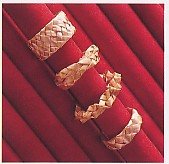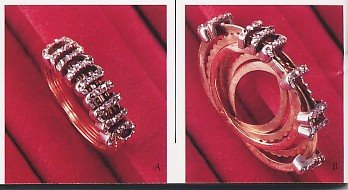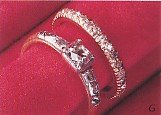
The Gift of LOVE...
...the 18th Century
A Gretna Green Wedding - A contemporary engraving in 1791 shows a hapless couple, marrying in haste, in less than salubrious circumstances. rush rings, of course, lasted about as long as the relationship.
"I'll crown thee with a garland of straw,
And I'll marry thee with a rush ring."
The use of rush rings to celebrate an alliance between a couple was mainly confined to improper liaisons. Just as the diamond is the symbol of performance so the rush ring was as fleeting as the union it blessed. But, for the wealthy and wise, the 18th century provided a sparkling galaxy of betrothal ans wedding rings.
The discovery of diamonds in Brazil increased the supply dramatically; diamond jewellery became the chief concern of the jeweller. At the same time, improved candle-lighting meant that more social events could take place at night, when these sparkling stones could be seen at the their best. Evey fashionable lady liked to appear with her fingers glittering with diamonds, both white and coloured. No other gem-stone had the charisma of the diamond, and so diamonds became a woman's favourite accomplice in society.
To meet the desire for sparkle, polishing techniques were again improved and rose cuts were superseded by the round brilliant. Settings were cut down to reveal more of the diamonds; and, to further expose the diamond's white sparkle, diamonds were set in silver to enhance their whiteness and brightness. In the same way, the old technique of lining settings with coloured metal foil was still used to emphasise other stones: red for a ruby, green for emerald. From about 1760, the backs of the rings were lined with gold to prevent tarnish rubbing off on a lady's finger.
By the mid-18th century, the light-hearted rocco spirit influenced design. Now that coloured as well as white diamonds were acceptable, the stones became more more and more the focus of elaborate design. There were many variants of the heart motif, set with both white and coloured diamonds, transfixed by arrows, twinned and crowned, or tied with a lover's knot.
 The late 18th century lady took great delight in showing off her delicate and clever little rings to her friends. In this example the word 'AMITE' (friendship) is set with small rose-cut diamonds. An endering messege from an admirer.
The late 18th century lady took great delight in showing off her delicate and clever little rings to her friends. In this example the word 'AMITE' (friendship) is set with small rose-cut diamonds. An endering messege from an admirer.
Set in silver the letters give the diamonsd a spark-ling whiteness. Each letter is mounted on a band of the thinnest gold, riveted at the base. The ring fans out when pulled open, and closes again to deliver its harmonious messege.
 The late 18th century lady took great delight in showing off her delicate and clever little rings to her friends. In this example the word 'AMITE' (friendship) is set with small rose-cut diamonds. An endering messege from an admirer.
The late 18th century lady took great delight in showing off her delicate and clever little rings to her friends. In this example the word 'AMITE' (friendship) is set with small rose-cut diamonds. An endering messege from an admirer.Set in silver the letters give the diamonsd a spark-ling whiteness. Each letter is mounted on a band of the thinnest gold, riveted at the base. The ring fans out when pulled open, and closes again to deliver its harmonious messege.
From the 1770's such emblems were replaced by loving declarations spelt out in diamond letters - SOUVENIR, AMITIE, AMOUR - on flat, dark blue enamelled bezels framed in pearls or rose-cut diamonds. There was also an ingenius extension of the gimmel principle were each letter was attached to a separate hoop which all came together to form one ring.
Pretty, delicate, colourful, feminine jewellry of this kind was the perfect expession of the elegant and refind taste of the period. Rings symbolic of love were treasured, and none more than the betrothal ring. Keeper rings, the forerunner of today's diamond eternity rings, made to be worn above the precious rings, became popular. To safeguard her wedding ring, Queen Charlotte placed a diamond keeper next to it on her finger. This keeper ring is still at Windsor Castle. Sentiment was not confined to fine ladies. The great lexicographer, Dr. Samuel Johnson, defined a ring in his dictionary as: a circular instrument placed upon the noses of hogs and the fingers of women to restrain them and bring them into subjection." All the same, after his wife's death, the devoted Dr. Johnson kept fer wedding ring in a box bearing the following insciption:
"Eheu! Eliza Johnson, Nupta July 9
1736, Mortua, eheu! Mar. 17, 1752."
In this century, the posy ring changed character. Instead of being hidden in the hoop, the inscirptions were decoratively enamelled on tn the outside - the sentiments suggesting light-hearted felivities rather than bsolemn intent. (Ironically, the Romantic motto "San peur" was the choice married Lord Byron inn 1815.) The enchanting history of the posy ring finally ended with the Wedding Ring Act which, by making full hall-marking compulsary, banished the space needed for inscriptions.
 The 17th century symbol of the heart crowned, as reward for faithful love, has been brought up-to-date by the mid 18th century jeweller. The heart-shaped bezel is set with a pear-shaped diamond, and diamonds embellish shoulder.
The 17th century symbol of the heart crowned, as reward for faithful love, has been brought up-to-date by the mid 18th century jeweller. The heart-shaped bezel is set with a pear-shaped diamond, and diamonds embellish shoulder.

There are many versions of the popular theme of crowned heart in the 18th century, and in this example the diamond for endurance is twinned with an emerald to give the stones an addaed brilliance. To seal the betrothal pledge the hearts are bound together and crowned with diamonds.

To protect her precious wedding ring ring Queen Charlotte wore a "keepr" or diamond hoop. A copy is above shown here with a more modest 18th century ring with diamond set in silver and mounted on a gold hoop. The silver does not challenge the whiteness of the diamonds but the gold protects the figure from tarnish.
 The 17th century symbol of the heart crowned, as reward for faithful love, has been brought up-to-date by the mid 18th century jeweller. The heart-shaped bezel is set with a pear-shaped diamond, and diamonds embellish shoulder.
The 17th century symbol of the heart crowned, as reward for faithful love, has been brought up-to-date by the mid 18th century jeweller. The heart-shaped bezel is set with a pear-shaped diamond, and diamonds embellish shoulder.
There are many versions of the popular theme of crowned heart in the 18th century, and in this example the diamond for endurance is twinned with an emerald to give the stones an addaed brilliance. To seal the betrothal pledge the hearts are bound together and crowned with diamonds.

To protect her precious wedding ring ring Queen Charlotte wore a "keepr" or diamond hoop. A copy is above shown here with a more modest 18th century ring with diamond set in silver and mounted on a gold hoop. The silver does not challenge the whiteness of the diamonds but the gold protects the figure from tarnish.


0 Comments:
Post a Comment
<< Home